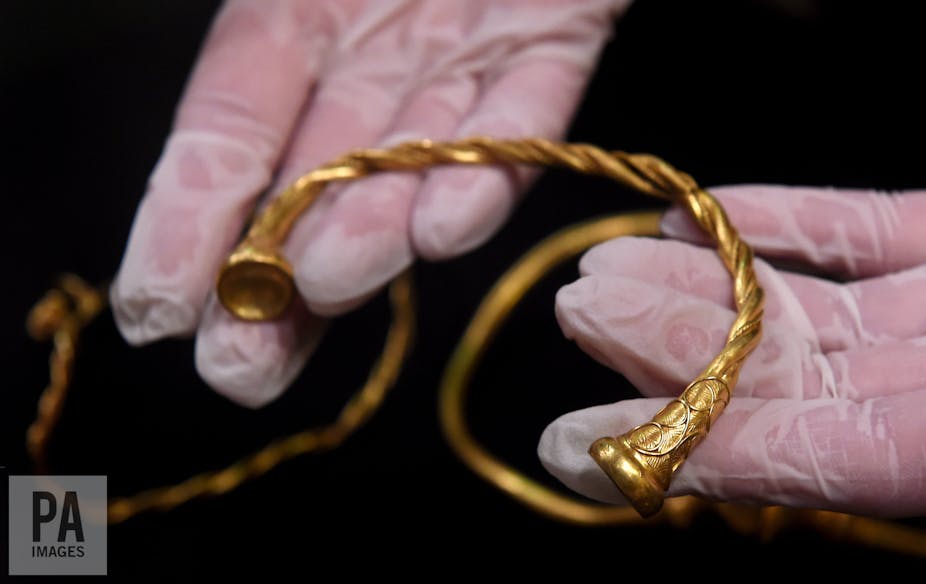Found by two metal detectorists in a Staffordshire field, the Leekfrith torcs are a spectacular example of late Iron Age jewellery and show just how skilled the pre-Roman inhabitants of Britain were in metalwork. But the torcs are not just beautiful and valuable objects, they also help archaeologists understand how Iron Age society worked.
Torcs were prehistoric bling, worn around the neck. As rigid pieces of jewellery they would have had to have been bent out of shape to put on and then adjusted once worn. Those found at Leekfrith are a rare and fantastic example of artistic skills that must have taken time and effort to produce – both indicators of their value and high status.
Hordes of torcs have often been found in Britain, with striking recent examples from Stirling in Scotland and Cambridgeshire. These would have been worn by powerful and wealthy men and and women as a symbol of their status. The very existence of torcs tells us a great deal about Iron Age society and how it was organised. For example, that gold torcs are found all over Britain and northern Europe indicates that there was trade between the elites of different regions, as gold sources are quite restricted.
The intricate decoration of torcs often shares certain artistic motifs, usually described as the celtic style and related to the La Tene culture of late Iron Age Europe. As well as objects and art styles moving around Europe, evidence from burials shows that people may have moved from modern France to Britain during the Iron Age – so pre-Roman Europe was a rather connected society.
Highly skilled trade
The skill required to make an intricate piece of jewellery such as a torc is learned over a lifetime of apprenticeship and practice – so it’s unlikely to have been a part-time job. This means that craftspeople would not have had time to farm their own food – the basic way of making a living in the Iron Age – and so they would have had to have been supported by others.
High ranking members of society would probably have ensured that collected food was distributed to the specialists they supported. And these elites may have also been the patrons of the metalworkers that did their goldwork for them. Seen like this, a golden torc on a Staffordshire hillside can reveal a lot about how societies worked and were structured in the past.
Experts often find it difficult to provide an accurate date when singular pieces of metalwork are found – hence the wide date range for the torcs estimated by the British Museum: 400-250 BC. However, we do know that throughout the late Iron Age, people were beginning to live in larger groups at hillfort sites like Danebury and Maiden Castle. Burial sites of very high status individuals have been found who were buried with impressive wealth. There is evidence – for example, at Hengistbury Head, Dorset – of trade between Britain and Mediterranean societies well before the Roman civilisation arrived at these so-called “barbarian” lands.
What this all points to is a society that was run by wealthy and powerful elites who displayed their status through the objects they wore. But the Staffordshire archaeologists have claimed that the Leekfrith torcs were buried on a hillside, with no associated burial or settlement remains – why is this so?

Status symbols
It could be that the torcs were buried for safekeeping in the middle of a tribal war, or there may have been a ritual or religious tradition in the Iron Age to bury valuable items. It’s possible that they were left as gifts for gods or natural deities but these deposits were usually made in watery places – the Battersea Shield and the Waterloo Helmet did not find their way into the River Thames by accident.
There would also have been a social as well as religious reason for this sort of activity – if people see you depositing your valuable jewellery, it is a way of showing your elite status and making others recognise it. The Leekfrith torcs represent a late Iron Age society that saw the rise of wealthy and powerful men and women.
These traditions would eventually give us the great warrior queens of the late Iron Age such as Boudica of the Iceni in Suffolk, who burned Roman Colchester, London and St Albans to the ground, and Cartimandua of the Brigantes in what is now northern England – both at one time feared and respected by the Roman Empire.
Ultimately, activity such as this sent the message that you are so wealthy that you can easily afford to part with four gold torcs – there’s plenty more where they came from.

